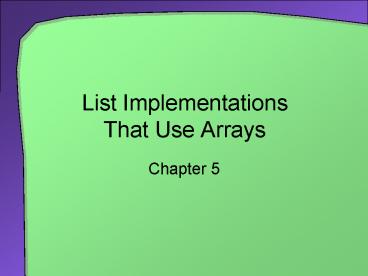List Implementations That Use Arrays - PowerPoint PPT Presentation
1 / 21
Title:
List Implementations That Use Arrays
Description:
The remove() Method. Must shift existing entries to avoid gap in the array ... Method must also handle error situation. When caller specifies invalid position ... – PowerPoint PPT presentation
Number of Views:43
Avg rating:3.0/5.0
Title: List Implementations That Use Arrays
1
List Implementations That Use Arrays
- Chapter 5
2
Chapter Contents
- Using a Fixed-Size Array to Implement the ADT
List - An Analogy
- The Java Implementation
- Using Dynamic Array Expansion
- Expanding an Array
- A News Implementation of a List
- Using a Vector to Implement the ADT List
- A Summary of Methods in the Class Vector
- The Pros and Cons of Using an Array
- The Class ArrayList
- The interface Serializable
3
An Analogy
- Consider a classroom with 40 desks in fixed
position - Desks are wasted if less than 40 students
- Not enough desks if more than 40 students
- An array is like the classroom
- Each desk an array location
4
An Analogy
Fig. 5-1 A classroom that contains desks in a
fixed position.
5
An Analogy
- Suppose we have some students in classroom in
order alphabetically - We add a new student
- We desire to maintain the alphabetic order
- We must shift some students
- We remove a student in the middle of the sequence
- Again, we must shift some students
6
Adding a Student
Fig. 5-2 Seating a new student between two
existing students at least one other student
must move
7
The Java Implementation
- Private data fields for AList
- Implements interface ListInterface of Chapter 4
- Note full specification, pgs 100-101
private static final int MAX_SIZE 50 private
Object entry // array of list entries private
int length // current entries
8
AList add() Methods
- add (object) adds at the end of the list
- Assign new value at end
- Increment length of list
- add(int, object)adds in mid-list
- Requires a utility method, makeRoom()
- Shifts higher-numbered elements ahead
9
Adding Items in Mid-list
Fig. 5-3 Making room to insert Carla as third
entry in an array.
10
The remove() Method
- Must shift existing entries to avoid gap in the
array - Except when removing last entry
- Method must also handle error situation
- When caller specifies invalid position
- When list is empty
- Our choice Invalid call returns null value
- Sometimes interface specifies (in documentation)
what the exceptional behaviors should be - Were choosing to fail soft here
11
Removing a List Entry
Fig. 5-4 Removing Bob by shifting array entries.
12
Dynamic Array Expansion
- An array has a fixed size
- If we need a larger list, we are in trouble
- When array becomes full
- Use a temporary object ref to point to old array
- Make a new, bigger array (dynamic expansion)
pointed to by the important object ref. - Copy data from old array to new array
- Throw out old array
13
Dynamic Array Expansion
Fig. 5-5 The dynamic expansion of an array copies
the array's contents to a larger second array.
14
Dynamic Array Expansion
Fig. 5-6 (a) an array (b) the
same array with two references
(c) the two arrays, reference to original array
now referencing a new,
larger array
15
A New Implementation of a List
- Change the isFull to always return false
- We will expand the array when it becomes full
- We keep this function so that the original
interface does not change - The add() methods will double the size of the
array when it becomes full - Now declare a private method isArrayFull
- Called by the add() methods
16
Using a Vector to Implement the ADT List
- Java's Vector class provides capabilities of an
array - Able to expand dynamically
- Hides the details of the process
- Vector
- Found in package java.util
- Has methods for manipulating entries
- Enables implementing the ADT List
17
Using a Vector
Fig. 5-7 A client uses the methods given in
ListInterface, but the implementation of the list
uses Vector methods to perform its operations
18
Using a Vector
- Elements of the class
- Class Vector comes from package java.util
- Data field entry is an instance of a Vector
import java.util.Vectorpublic class VectorList
implements ListInterface private Vector entry
// entries in list . . .
19
Using a Vector
- The add() methods
- The first uses the addElement method from the
Vector class - The other uses the insertElementAt method
- The remove() method
- Uses the removeElementAt method
20
Pros and Cons of Array Use for the ADT List
- When using an array or vector
- Retrieving an entry is fast
- Adding / removing at the end of the list is fast
- Adding / removing anywhere else requires shifting
elements (less shifting near the end) - Increasing the size of the array or vector
requires copying elements
21
Java Class Library
- java.util.ArrayList is similar to class AList
defined in this chapter - Uses dynamic array expansion
- Interface Serializable
- Represent an object as a sequence of bytes to be
written to a file or over a network - Add the words implements Serializable to class
definition
public class AList implements ListInterface,
java.io.Serializable . . .































